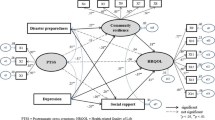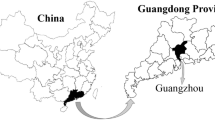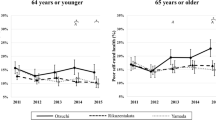Abstract
As one of the most destructive natural disasters, earthquakes affect the health of survivors. The devastating earthquakes that hit Sichuan, China have aroused the concern of domestic and international scholars. The health-related quality of life (HRQOL) of survivors also requires substantial research. Studies on impact factors, such as gender, age, monthly income, and education, have become controversial. The subjects in this study are the people of five hard-hit disaster counties in Sichuan Province, namely, Wenchuan, Qingchuan, Mianzhu, Lushan, and Dujiangyan. A preliminary survey was conducted in May and June 2013 in areas badly hit by the earthquake in Sichuan, China. A total of 2000 questionnaires were distributed, and 1672 of which were received, yielding a recovery rate of 83.6 %. To further complement and corroborate the conclusions, a follow-up survey was conducted in October and November 2013, where 1526 effective questionnaires were received. The analysis in this paper is mainly based on the first survey, and the collected data from the follow-up survey were used to perform a supplementary analysis. By analyzing data from five hard-hit areas in Sichuan and by establishing models, we drew the following conclusions: The results of analysis of variance and Tukey’s honestly significant difference tests revealed the following results. First, the results of two investigations indicate the HRQOL of earthquake survivors is relatively poor, especially in terms of general health (GH), mental health (MH), social functioning (SF), etc. However, results of the second survey indicate that the scores of all domains (except GH) have increased significantly, with the SF having the most significant increase. Second, the HRQOL scores of men are higher than those of women. Individuals with higher education or monthly income have higher HRQOL scores than those with lower education or income. Moreover, younger survivors have higher HRQOL scores than older survivors. Third, a positive correlation exists among the HRQOL domains of all survivors. Among all domains, the PF, RP, GH, MH, and VT of survivors have a very strong correlation. In addition, SF, BP, MH, and VT have a strong correlation. Other variables have a relatively weak correlation.







Similar content being viewed by others
Notes
The two photos below were taken in Guangyuan and Ya’an, two of the sites where the questionnaires were distributed.
Abbreviations
- HRQOL:
-
Health-related quality of life
- SF-36:
-
Medical outcome study short form 36
- PCS:
-
Physical component summary
- MCS:
-
Mental component summary
- CFA:
-
Confirmatory factor analysis
- ANOVA:
-
Analysis of variance
- 1st Qu:
-
One fourth quartile
- 3rd Qu:
-
Three quarter quartile
- PF:
-
Physical functioning
- RP:
-
Role physical
- RE:
-
Role emotional
- SF:
-
Social functioning
- BP:
-
Body pain
- GH:
-
General health
- VT:
-
Vitality
- MH:
-
Mental health
References
Ashing-Giwa, K. T. (2005). The contextual model of HRQoL: A paradigm for expanding the HRQoL framework. Quality of Life Research, 14(2), 297–307.
Brock, T. K., Mecozzi, D. M., Sumner, S., & Kost, G. J. (2010). Evidence-based point-of-care tests and device designs for disaster preparedness. American journal of disaster medicine, 5(5), 285.
Burckhardt, C. S., & Anderson, K. L. (2003). The quality of life scale (QOLS): Reliability, validity, and utilization. Health and quality of life outcomes, 1(1), 60.
Chen, J. (2011). Internal migration and health: Re-examining the healthy migrant phenomenon in China. Social Science and Medicine, 72(8), 1294–1301.
Chou, F. C., Chou, P., Lin, C., Su, T. T. P., Ou-Yang, W. C., Chien, I. C., et al. (2004). The relationship between quality of life and psychiatric impairment for a Taiwanese community post-earthquake. Quality of Life Research, 13(6), 1089–1097.
Cummins, R. A., Lau, A. L., & Stokes, M. (2004). HRQOL and subjective well-being: Noncomplementary forms of outcome measurement. Expert Review of Pharmacoeconomics and Outcomes Research, 4(4), 413–420.
Dell’Osso, L., Carmassi, C., Massimetti, G., Daneluzzo, E., Di Tommaso, S., & Rossi, A. (2011). Full and partial PTSD among young adult survivors 10 months after the L’Aquila 2009 earthquake: Gender differences. Journal of Affective Disorders, 131(1), 79–83.
Desouky, T. F., Mora, P. A., & Howell, E. A. (2013). Measurement invariance of the SF-12 across European-American, Latina, and African-American postpartum women. Quality of Life Research, 1–10.
Fuh, J. L., Wang, S. J., Lu, S. R., Juang, K. D., & Lee, S. J. (2000). Psychometric evaluation of a Chinese (Taiwanese) version of the SF-36 health survey amongst middle-aged women from a rural community. Quality of Life Research, 9(6), 675–683.
Gandhi, P. K., Ried, L. D., Huang, I. C., Kimberlin, C. L., & Kauf, T. L. (2013). Assessment of response shift using two structural equation modeling techniques. Quality of Life Research, 1–11.
Goenjian, A. K., Roussos, A., Steinberg, A. M., Sotiropoulou, C., Walling, D., Kakaki, M., et al. (2011). Longitudinal study of PTSD, depression, and quality of life among adolescents after the Parnitha earthquake. Journal of Affective Disorders, 133(3), 509–515.
Gothwal, V. K., Srinivas, M., & Rao, G. N. (2013). A new look at the WHOQOL as health-related quality of life instrument among visually impaired people using Rasch analysis. Quality of Life Research, 1–13.
Guyatt, G. H., Feeny, D. H., & Patrick, D. L. (1993). Measuring health-related quality of life. Annals of Internal Medicine, 118(8), 622–629.
Herdman, M., Fox-Rushby, J., & Badia, X. (1998). A model of equivalence in the cultural adaptation of HRQOL instruments: The Universalist approach. Quality of Life Research, 7(4), 323–335.
Jia, Z., Tian, W., He, X., Liu, W., Jin, C., & Ding, H. (2010). Mental health and quality of life survey among child survivors of the 2008 Sichuan earthquake. Quality of Life Research, 19(9), 1381–1391.
Jorm, A. F. (2000). Mental health literacy public knowledge and beliefs about mental disorders. The British Journal of Psychiatry, 177(5), 396–401.
Ke, X., Liu, C., & Li, N. (2010). Social support and quality of life: A cross-sectional study on survivors eight months after the 2008 Wenchuan earthquake. BMC Public Health, 10(1), 573.
Kiliç, E. Z., Özgüven, H. D., & Sayil, I. (2003). The psychological effects of parental mental health on children experiencing disaster: The experience of Bolu earthquake in Turkey. Family Process, 42(4), 485–495.
Lam, C. L., Eileen, Y. Y., & Gandek, B. (2005). Is the standard SF-12 health survey valid and equivalent for a Chinese population? Quality of Life Research, 14(2), 539–547.
Lee, Y. E., Baek, H. J., Choi, Y. H., Jeong, S. H., Park, Y. D., & Song, K. B. (2010). Comparison of remineralization effect of three topical fluoride regimens on enamel initial carious lesions. Journal of Dentistry, 38(2), 166–171.
Lim, S., Choi, H. J., Shin, H., Khang, A. R., Kang, S. M., Yoon, J. W., et al. (2012). Subclinical atherosclerosis in a community-based elderly cohort: The Korean longitudinal study on health and aging. International journal of cardiology, 155(1), 126–133.
Liu, C., Li, N., Ren, X., & Liu, D. (2010). Is traditional rural lifestyle a barrier for quality of life assessment? A case study using the Short Form 36 in a rural Chinese population. Quality of Life Research, 19(1), 31–36.
Nesterko, Y., Braehler, E., Grande, G., & Glaesmer, H. (2013). Life satisfaction and health-related quality of life in immigrants and native-born Germans: The role of immigration-related factors. Quality of Life Research, 1–9.
O’ Neil, A., Stevenson, C. E., Williams, E. D., Mortimer, D., Oldenburg, B., & Sanderson, K. (2013). The health-related quality of life burden of co-morbid cardiovascular disease and major depressive disorder in Australia: Findings from a population-based, cross-sectional study. Quality of life research, 22(1), 37–44.
Qu, B., Guo, HQ., Liu, J., Zhang, Y., & Sun, G,. (2009). Reliability and validity testing of the SF-36 questionnaire for the evaluation of the quality of life of Chinese Urban construction workers. Journal of International Medical Research, 37(4), 1184–1190.
Quinn, G. P., Huang, I. C., Murphy, D., Zidonik-Eddelton, K., & Krull, K. R. (2013). Missing content from health-related quality of life instruments: Interviews with young adult survivors of childhood cancer. Quality of Life Research, 22(1), 111–118.
Siegrist, J., Shackelton, R., Link, C., Marceau, L., von dem Knesebeck, O., & McKinlay, J. (2010). Work stress of primary care physicians in the US, UK and German health care systems. Social Science and Medicine, 71(2), 298–304.
Sprangers, M. A., & Schwartz, C. E. (1999). Integrating response shift into health-related quality of life research: a theoretical model. Social Science and Medicine, 48(11), 1507–1515.
Su, C. Y., Tsai, K. Y., Chou, F. H. C., Ho, W. W., Liu, R., & Lin, W. K. (2010). A three-year follow-up study of the psychosocial predictors of delayed and unresolved post-traumatic stress disorder in Taiwan Chi–Chi earthquake survivors. Psychiatry and Clinical Neurosciences, 64(3), 239–248.
Tan, M. L., Wee, H. L., Lee, J., Ma, S., Heng, D., Tai, E. S., et al. (2013) Association of anthropometric measures with SF-36v2 PCS and MCS in a multi-ethnic Asian population. Quality of Life Research, 1–10.
Touma, Z., Gladman, D. D., Ibañez, D., & Urowitz, M. B. (2011). Is there an advantage over SF-36 with a quality of life measure that is specific to systemic lupus erythematosus? The Journal of rheumatology, 38(9), 1898–1905.
Wang, L., Cao, C., Wang, R., Zhang, J., & Li, Z. (2012). The dimensionality of PTSD symptoms and their relationship to health-related quality of life in Chinese earthquake survivors. Journal of Anxiety Disorders, 26(7), 711–718.
Ware, J. E, Jr. (2000). SF-36 health survey update. Spine, 25(24), 3130–3139.
Ware Jr, J. E., & Gandek, B. (1998) Overview of the SF-36 health survey and the international quality of life assessment (IQOLA) project. Journal of clinical epidemiology, 51(11), 903–912.
Yoon, S. L., Grundmann, O., Keane, D., Urbano, T., & Moshiree, B. (2012). Clinical evaluation of liquid placebos for an herbal supplement, STW5, in healthy volunteers. Complementary Therapies in Medicine, 20(5), 267–274.
Yu, J., Coons, S. J., Draugalis, J. R., Ren, X. S., & Hays, R. D. (2003). Equivalence of Chinese and US-english versions of the SF-36 health survey. Quality of Life Research, 12(4), 449–457.
Zhang, J., Li, X., Fang, X., & Xiong, Q. (2009). Discrimination experience and quality of life among rural-to-urban migrants in China: The mediation effect of expectation–reality discrepancy. Quality of Life Research, 18(3), 291–300.
Zhang, Y., Kong, F., Wang, L., Chen, H., Gao, X., Tan, X., et al. (2010). Mental health and coping styles of children and adolescent survivors one year after the 2008 Chinese earthquake. Children and Youth Services Review, 32(10), 1403–1409.
Zhang, Z., Shi, Z., Wang, L., & Liu, M. (2011). One year later: Mental health problems among survivors in hard-hit areas of the Wenchuan earthquake. Public health, 125(5), 293–300.
Zhang, X., Hu, X. R., Reinhardt, J. D., Zhu, H. J., Gosney, J. E., Liu, S. G., et al. (2012). Functional outcomes and health-related quality of life in fracture victims 27 months after the Sichuan earthquake. Journal of Rehabilitation Medicine, 44(3), 206–209.
Zhu, C. Y., Wang, J. J., Fu, X. H., Zhou, Z. H., Zhao, J., & Wang, C. X. (2012). Correlates of quality of life in China rural–urban female migrate workers. Quality of Life Research, 21(3), 495–503.
Acknowledgments
This paper is supported by the General Program of National Natural Science Foundation of China (71173099) and the Program for New Century Excellent Talents in University (NCET-11-0228). The authors would also like to thank Peiyi Lu (School of Communication and Design of Sun Yat-sen University) for her contributions to this study and Shu Zhang (School of Humanities and Social Sciences of Nanjing University of Science & Technology) for her contributions to the survey.
Conflict of interests
The authors declare that they have no conflict interests.
Author information
Authors and Affiliations
Corresponding author
Rights and permissions
About this article
Cite this article
Liang, Y., Chu, P. & Wang, X. Health-Related Quality of Life of Chinese Earthquake Survivors: A Case Study of Five Hard-Hit Disaster Counties in Sichuan. Soc Indic Res 119, 943–966 (2014). https://doi.org/10.1007/s11205-013-0525-2
Accepted:
Published:
Issue Date:
DOI: https://doi.org/10.1007/s11205-013-0525-2




